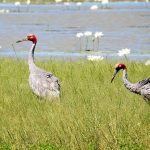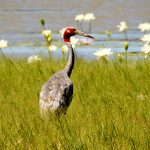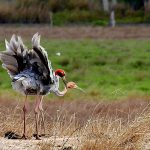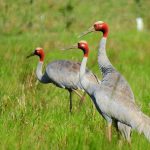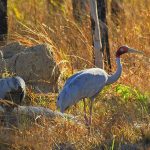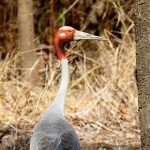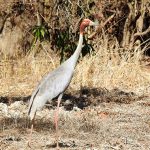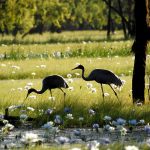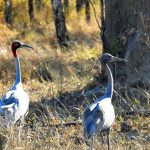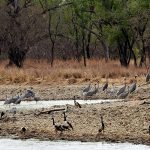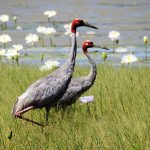SARUS CRANE
Australia’s Gentle Giant
Imagine the break of dawn across the wetlands of northern Australia. A cool mist hangs over tall grasses. Through the haze, a tall, stately bird emerges, its elegant form reflected in the still water. This is the Sarus Crane, the tallest flying bird in the world and a timeless symbol of grace and endurance in Australia’s wild landscapes.
Physical Appearance
- Height: Up to 1.8 m (6 feet) tall—taller than many people.
- Wingspan: Stretches to an impressive 2.5 metres.
- Colouration: The crane’s plumage is primarily a delicate pale grey. The most striking feature is its bare red head and upper neck, contrasting sharply with snowy white feathers further down.
- Eyes and Beak: Its eyes are an intense orange-red, gazing out above a long, pointed greyish bill.
Habitat and Range
The Australian subspecies of the Sarus Crane lives mostly in:
| Region | Habitat Types |
|---|---|
| Northern Queensland | Floodplains, wetlands |
| Gulf of Carpentaria | Wet grasslands, marshes |
- During the dry season, Sarus Cranes are drawn to larger wetlands and grasslands, where they search for food among tall reeds and shallow pools.
Behaviour and Diet
- Social Structure: Sarus Cranes are often seen in pairs or small family groups, particularly during breeding season. Outside this time, they sometimes gather in flocks.
- Vocalisation: Their calls are low, trumpeting sounds that echo across the open wetlands, especially at dawn and dusk—a truly evocative, haunting sound.
- Courtship Display: Pairs perform elaborate dances, leaping into the air, bowing, and tossing sticks or grass. These rituals strengthen their bonds and can be mesmerising to watch.
- Feeding: Their diet consists of:
- Turmeric-coloured roots and tubers
- Insects, frogs, and occasionally small reptiles
- Seeds and grain in the dry season
Reproduction and Life Cycle
- Nesting: Sarus Cranes build massive nests out of reeds and grasses, usually on small islands or grassy mounds in wetlands.
- Eggs: Nests contain one or two large eggs, which both parents take turns incubating.
- Chicks: Fluffy and yellow on hatching, the young soon follow their parents through the wetlands, learning to forage and avoid danger.
Conservation and Cultural Significance
- Status: The Australian Sarus Crane is considered uncommon and is vulnerable to habitat changes, especially the drainage of wetlands for agriculture.
- Cultural Role: In some Indigenous Australian cultures, cranes feature in creation stories and are respected as symbols of lifelong partnership because of their monogamous behaviour.
- Conservation Message: Protecting wetlands not only supports Sarus Cranes but also helps countless other species, underscoring the interconnectedness of these habitats.
Sensory Experience
Close your eyes and imagine:
- The soft touch of dew-drenched grass beneath your feet.
- The deep, flute-like call of a Sarus Crane resonating across a still morning.
- The earthy scent of wetland plants and damp soil.
- The graceful movement of these birds, their wings slicing through the mist as the sun rises.
Why Sarus Cranes Matter
The Sarus Crane inspires awe with its size, beauty, and gentle nature. It stands as a living reminder of the delicate balance in Australian wetlands—a balance we are all responsible for protecting. By appreciating and conserving these birds and their habitats, we ensure that this ancient dance continues for generations to come.
To sum up:
The Sarus Crane is not just a bird of Australia’s wetlands; it is a symbol of resilience, connection, and the majesty of the natural world. By caring for its environment, we help preserve a vital chapter of Australia’s rich wildlife story.

